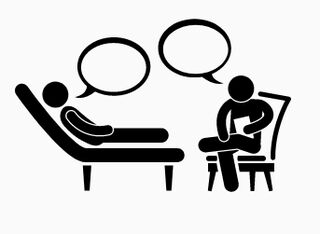Transference
On Being a Therapist: The Good, Bad, and the Ugly
A therapist works in psychological reality, making it a challenging career.
Posted October 25, 2021 Reviewed by Tyler Woods
Key points
- Being a therapist creates unresolved conflicts affecting the therapist's personal life.
- The client is not a random sample of humanity. You hear a lot of suffering and complaints about bad actors.
- The heart of all therapies is understanding transference, countertransference, resistance, and counterresistance.

"Where do you work?" It seems like an easy question.
I work in psychological reality: the world of people, places, and circumstances. All therapists work in this plane of existence, as opposed to physical reality: the material world.
Our senses evolved to know something about physical reality, but they did much less so about evolved meaning and interpretation in psychological reality. Psychological reality finds truth in interpretation while physical reality, truth in objectification, hence the profession of psychotherapy to facilitate and accelerate understanding this "world."
The transition from philosophy to psychology was to understand human nature.
The field of philosophy emerged to make sense of what is real and what is true (an area of epistemology and the study of knowledge). The field of psychology took this inquiry further, to investigate what is real and what is true via the scientific method.
William James, a founder of the field of psychology, was first a philosopher and then a psychologist. The "problem" with being a therapist is that you work in the gray area between philosophy and psychology. What is real and true to a client may not be real and true to you, or known via published research to be true, but you rarely say to a client, "You are wrong." Therapy is more subtle and nuanced, and translating published psychological science into practice is complicated.
Different therapeutic schools of thought share similar clinical terms.
Many clinical terms used to describe therapeutic communication remain psychoanalytic, but all deal with the interpersonal relationship between client and therapist. Living in another person's (psychological) reality does a number on most full-time therapists' heads.
Each reality has different standards of measurement.
The reason for this conflict and tension is evident. In physical reality, if I hold a red apple to a client who says it is yellow, there could be neurological problems, obstinance, agnosia, or color blindness. Red is the phenomenology of our photoreceptor perception of a long wavelength. It is objective in nanometers along the visible electromagnetic spectrum. However, if the same client says, "I resent how you think my mother's abusive child-rearing caused my problem," that is an interpretive statement subject to the abstract rules of psychological reality. Its etiology is not as quickly determined. To a therapist, this confusion can be frustrating.
Mental measurement seeks to objectify what remains subjective.
The field of mental measurement seeks to make psychological reality into physical reality. It doesn't always work. This translation failure is a significant stressor for most practicing psychologists. Why? Mental measurements simulate truth in the objectification of physical reality via standardized, reliable, and valid psychological tests. For example, the MMPI-2 is an "actuarial" test, meaning the clinician requires less interpretation of the results than a projective test like a figure drawing or the inkblot test.
Psychological reality relies on objectifying ideas through "operational definitions." In contrast, physical reality has formulas: F=MA. If you know two of the three variables, you can generate a true solution, but not so in a psychological reality, where things do not "add up" as cleanly, where putting two and two together is not the same as adding 2+2.
There are standards to measure subjective responses (for instance, what a laughing child means if a percept during the inkblot test). These operationally defined standards are labeled by many other fields as "unscientific" measurements in physical reality, although it should be noted that science is a method and not a subject matter.
A therapist wants to be "scientific," but where they work tends to prevent it.
This disparity between the objective-subjective and the figurative-literal places tremendous pressure on a therapist to understand where the client is coming from in psychological reality. A client can say, "I am from Chicago," and we can locate Chicago on a map. If the same client says, "you have no idea where I am coming from," the client may be correct. By inference, they provide the therapist with an interpretation of emotional memory. I have no idea (but more so with fMRI imaging) where interpretive memory exists in the geography of their brain. This neurological subjectivity is yet another stressor for therapists.
In addition, a therapist does not label these emotional memories as right or wrong. Psychological reality is far from binary. In "reality," the statement is along a continuum of ambiguity resolved interpersonally. This resolution is the "process" of psychotherapy. It is the components of this resolution that weighs on the personal psychology of the therapist.
Still, I do not place a negative connotation on this process, only that it is more subjective than most people like and certainly has no relationship to how people talk and interact in real life.
There are four components to resolve interpersonal conflict in psychological reality.
The four components to resolve conflict in truth and interpretation is independent one's school of thought, a statement that may surprise you. A psychoanalyst and a behavioral therapist have to deal with the rules of psychological reality whether they desire to or not. Adherence to these rules is inherent in the process of doing psychotherapy and can be wearing on the therapist's mind. The four features of reassembling the puzzle of "where a person is at" include well-known references:
- Transference
- Resistance and their polarities
- Countertransference
- Counterresistance
Transference is a client "transferring feelings onto the therapist that is felt or experienced towards someone else." It is a product of therapy.
Countertransference is the therapist's emotional response to this awareness of projection (a defense mechanism).
Resistance is how a client copes with ambiguous subjects and is linked to the presenting complaint. It might be manifested as denial, being late, or ending therapy.
Counterresistence is how the therapist feels about the client's resistance. Still, it is different from countertransference in that the therapist's feelings may well be true based on the therapist's own unknown or unresolved conflicts and who the client is or reminds the therapist of. It is often independent of therapy and can delve into issues from the therapist's own life.
Counteresistence is the least understood form of conflict resolution among clients and therapists. For example, suppose a therapist is separated from his or her spouse, and a couple comes in, also separated. In that case, the counterresistance to that couple's resolution of conflicts is more complicated than if the therapist was not separated. Why? The therapist is a human being and also lives in the material world of people, places, and circumstances.
Transitioning from one reality to another takes a mental toll.
Understanding that a therapist works in psychological reality comprised of ideas versus a physical reality comprised of neurons means doing therapy takes a psychological toll on the therapist. This toll may require "decompression" from office to home, like divers slowly rising from the depths of the ocean back to the surface, avoiding "the bends."
In this case, the equivalent of the "bends" is the therapist coping with the unresolved countertransference conflicts and counterresistence. Every therapist worth their salt experiences this dilemma. You are bound to think about how a session might have gone better, whether your resistance made the session less effective.
Another practical problem in being a therapist is that the transition from philosophy to psychology is nonlinear. You can read books for years on how to do therapy and still not be any good at it. To master being a therapist, you have to do therapy to learn the nuances of navigating psychological reality, symbolic thinking that, in our species, is equated to "the mind."
There is the good, bad, and ugly working in psychological reality.
Making a living in psychological reality takes more of a mental toll than the other professions, or that is my assertion, at least. No one tells you this going in, but after 50 years, you know it coming out.
A therapist is supposed to be a perfect human being in session, then leave and deal with "real life," where they may find themselves unable to be as empathic in many of the same situations presented during therapy. Thus, being a therapist is good, bad, and ugly, given the various juggling acts and ambiguous roles and skillsets involved in seeking to integrate the major current forms of truth.
References
Kottler, J.A. and Carlson, J. (2003) BAD THERAPY: Master Therapists Share Their Worst Failures. Brunner-Routledge, New York
Bernstein, G.E. (2018) The Heart Is My Beat: Inside the Work and Life of a Psychotherapist. Kindle. Self Published.


